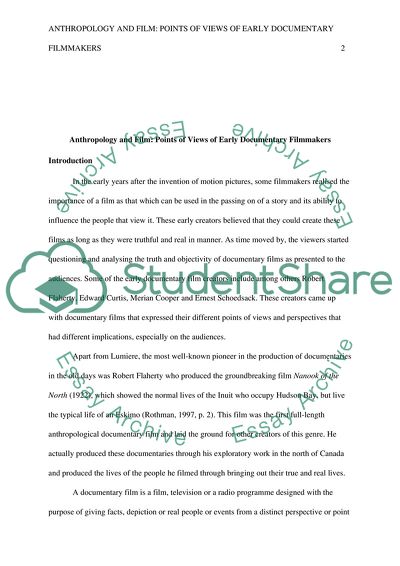Cite this document
(“Points of Views of Early Documentary Filmmakers Research Paper”, n.d.)
Points of Views of Early Documentary Filmmakers Research Paper. Retrieved from https://studentshare.org/visual-arts-film-studies/1820300-anthropology-and-film-documentary-film-represents-its-subjects-from-a-distinct-perspective-or-point-of-view-how-would-you-identify-the-point-of-view-of-early-documentary-filmmakers-and-what-implications-might-this-have-for-the-representation-of-others
Points of Views of Early Documentary Filmmakers Research Paper. Retrieved from https://studentshare.org/visual-arts-film-studies/1820300-anthropology-and-film-documentary-film-represents-its-subjects-from-a-distinct-perspective-or-point-of-view-how-would-you-identify-the-point-of-view-of-early-documentary-filmmakers-and-what-implications-might-this-have-for-the-representation-of-others
(Points of Views of Early Documentary Filmmakers Research Paper)
Points of Views of Early Documentary Filmmakers Research Paper. https://studentshare.org/visual-arts-film-studies/1820300-anthropology-and-film-documentary-film-represents-its-subjects-from-a-distinct-perspective-or-point-of-view-how-would-you-identify-the-point-of-view-of-early-documentary-filmmakers-and-what-implications-might-this-have-for-the-representation-of-others.
Points of Views of Early Documentary Filmmakers Research Paper. https://studentshare.org/visual-arts-film-studies/1820300-anthropology-and-film-documentary-film-represents-its-subjects-from-a-distinct-perspective-or-point-of-view-how-would-you-identify-the-point-of-view-of-early-documentary-filmmakers-and-what-implications-might-this-have-for-the-representation-of-others.
“Points of Views of Early Documentary Filmmakers Research Paper”, n.d. https://studentshare.org/visual-arts-film-studies/1820300-anthropology-and-film-documentary-film-represents-its-subjects-from-a-distinct-perspective-or-point-of-view-how-would-you-identify-the-point-of-view-of-early-documentary-filmmakers-and-what-implications-might-this-have-for-the-representation-of-others.


